英文原版教材《营销调研:方法论基础》第四章——调研设计ch04researchdesign
- 格式:doc
- 大小:348.00 KB
- 文档页数:36
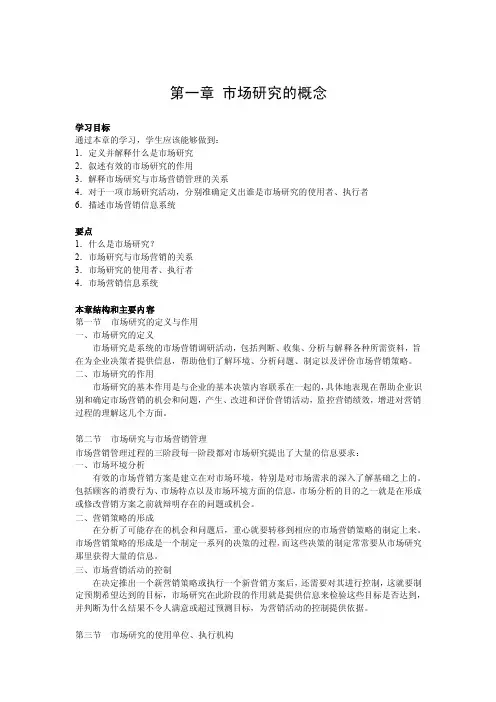
第一章市场研究的概念学习目标通过本章的学习,学生应该能够做到:1.定义并解释什么是市场研究2.叙述有效的市场研究的作用3.解释市场研究与市场营销管理的关系4.对于一项市场研究活动,分别准确定义出谁是市场研究的使用者、执行者6.描述市场营销信息系统要点1.什么是市场研究?2.市场研究与市场营销的关系3.市场研究的使用者、执行者4.市场营销信息系统本章结构和主要内容第一节市场研究的定义与作用一、市场研究的定义市场研究是系统的市场营销调研活动,包括判断、收集、分析与解释各种所需资料,旨在为企业决策者提供信息,帮助他们了解环境、分析问题、制定以及评价市场营销策略。
二、市场研究的作用市场研究的基本作用是与企业的基本决策内容联系在一起的,具体地表现在帮助企业识别和确定市场营销的机会和问题,产生、改进和评价营销活动,监控营销绩效,增进对营销过程的理解这几个方面。
第二节市场研究与市场营销管理市场营销管理过程的三阶段每一阶段都对市场研究提出了大量的信息要求:一、市场环境分析有效的市场营销方案是建立在对市场环境,特别是对市场需求的深入了解基础之上的。
包括顾客的消费行为、市场特点以及市场环境方面的信息,市场分析的目的之一就是在形成或修改营销方案之前就辩明存在的问题或机会。
二、营销策略的形成在分析了可能存在的机会和问题后,重心就要转移到相应的市场营销策略的制定上来。
市场营销策略的形成是一个制定一系列的决策的过程,而这些决策的制定常常要从市场研究那里获得大量的信息。
三、市场营销活动的控制在决定推出一个新营销策略或执行一个新营销方案后,还需要对其进行控制,这就要制定预期希望达到的目标,市场研究在此阶段的作用就是提供信息来检验这些目标是否达到,并判断为什么结果不令人满意或超过预测目标,为营销活动的控制提供依据。
第三节市场研究的使用单位、执行机构一、使用市场研究的单位使用市场研究的单位可以分为下面几个类型:1.消费品制造企业这类企业主要依靠市场调研来测试新产品、新包装,设计以及测试促销方案的有效程度,调查本公司商标名称及公司的形象等。
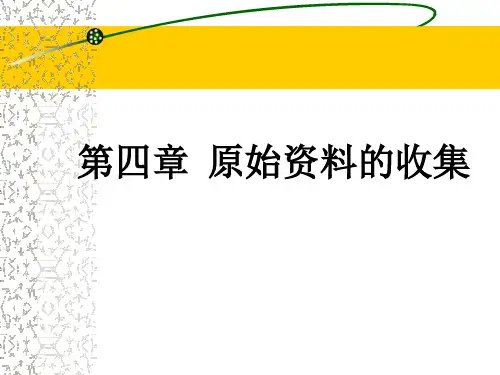

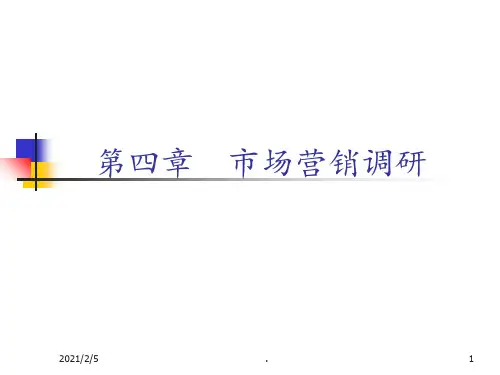
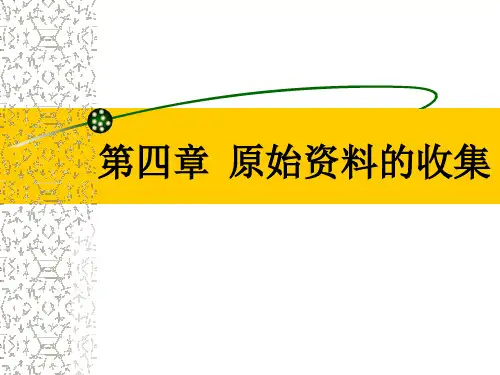
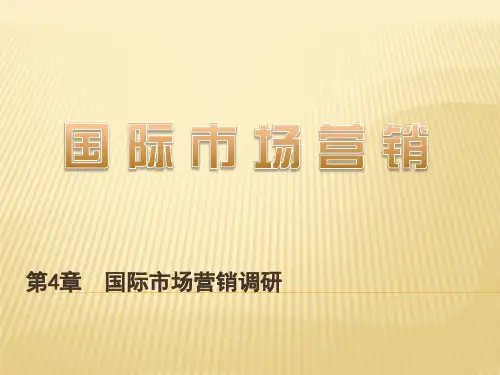
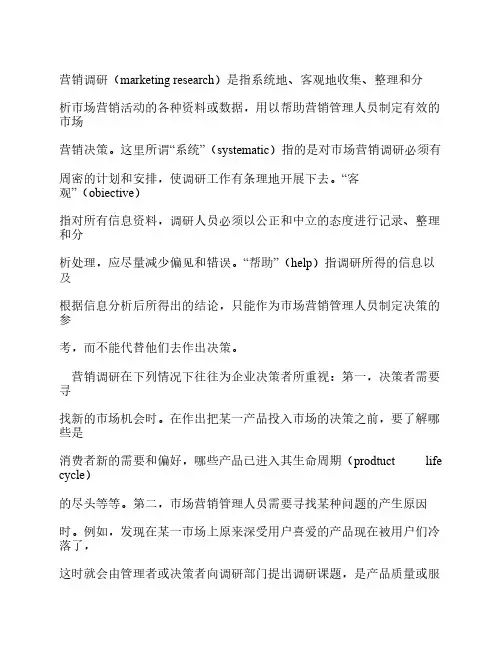
营销调研(marketing research)是指系统地、客观地收集、整理和分析市场营销活动的各种资料或数据,用以帮助营销管理人员制定有效的市场营销决策。
这里所谓“系统”(systematic)指的是对市场营销调研必须有周密的计划和安排,使调研工作有条理地开展下去。
“客观”(obiective)指对所有信息资料,调研人员必须以公正和中立的态度进行记录、整理和分析处理,应尽量减少偏见和错误。
“帮助”(help)指调研所得的信息以及根据信息分析后所得出的结论,只能作为市场营销管理人员制定决策的参考,而不能代替他们去作出决策。
营销调研在下列情况下往往为企业决策者所重视:第一,决策者需要寻找新的市场机会时。
在作出把某一产品投入市场的决策之前,要了解哪些是消费者新的需要和偏好,哪些产品已进入其生命周期(prodtuct life cycle)的尽头等等。
第二,市场营销管理人员需要寻找某种问题的产生原因时。
例如,发现在某一市场上原来深受用户喜爱的产品现在被用户们冷落了,这时就会由管理者或决策者向调研部门提出调研课题,是产品质量或服量下降了,还是消费者或用户的偏好有所变化。
第三,决策者在制定决策后必须在其实施过程中进行监测、评价和调整。
许多情况下,市营销调研就是针对决策是否有效而进行的,分析一项新的决策是否使市场营销活动向更为有利的方向发展。
第四,预测未来。
调研为预测提供资料依据,预测的准确性很大程度上取决于市场营销调研的质量。
营销调研与预测是密切联系又有区别的两个概念。
营销调研与营销信息系统营销调研的程序营销调研的内容营销调研开展前应考虑的主要问题营销调研活动的开展需要准确、及时地收集各种信息,而营销调研活动的结果也表现为向企业管理和决策者提供各种信息。
营销调研活动的广泛开展,营销调研方法的科学发展使营销调价本身日趋复杂,加上各种信息接受、整理、储存、提供设备的采用,使营销信息极需建立一个不断有序化的机构,这就提出了营销信息系统的问题。
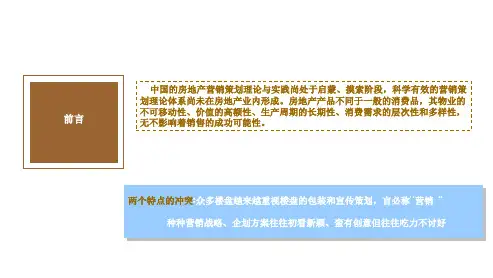
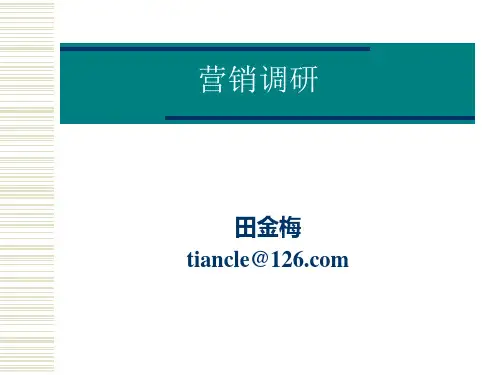
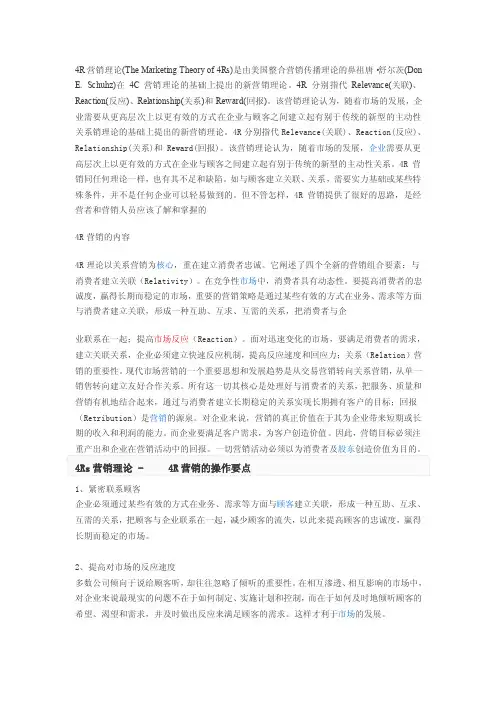
4R营销理论(The Marketing Theory of 4Rs)是由美国整合营销传播理论的鼻祖唐·舒尔茨(Don E. Schuhz)在4C营销理论的基础上提出的新营销理论。
4R分别指代Relevance(关联)、Reaction(反应)、Relationship(关系)和Reward(回报)。
该营销理论认为,随着市场的发展,企业需要从更高层次上以更有效的方式在企业与顾客之间建立起有别于传统的新型的主动性关系销理论的基础上提出的新营销理论。
4R分别指代Relevance(关联)、Reaction(反应)、Relationship(关系)和Reward(回报)。
该营销理论认为,随着市场的发展,企业需要从更高层次上以更有效的方式在企业与顾客之间建立起有别于传统的新型的主动性关系。
4R营销同任何理论一样,也有其不足和缺陷。
如与顾客建立关联、关系,需要实力基础或某些特殊条件,并不是任何企业可以轻易做到的。
但不管怎样,4R营销提供了很好的思路,是经营者和营销人员应该了解和掌握的4R营销的内容4R理论以关系营销为核心,重在建立消费者忠诚。
它阐述了四个全新的营销组合要素:与消费者建立关联(Relativity)。
在竞争性市场中,消费者具有动态性。
要提高消费者的忠诚度,赢得长期而稳定的市场,重要的营销策略是通过某些有效的方式在业务、需求等方面与消费者建立关联,形成一种互助、互求、互需的关系,把消费者与企业联系在一起;提高市场反应(Reaction)。
面对迅速变化的市场,要满足消费者的需求,建立关联关系,企业必须建立快速反应机制,提高反应速度和回应力;关系(Relation)营销的重要性。
现代市场营销的一个重要思想和发展趋势是从交易营销转向关系营销,从单一销售转向建立友好合作关系。
所有这一切其核心是处理好与消费者的关系,把服务、质量和营销有机地结合起来,通过与消费者建立长期稳定的关系实现长期拥有客户的目标;回报(Retribution)是营销的源泉。
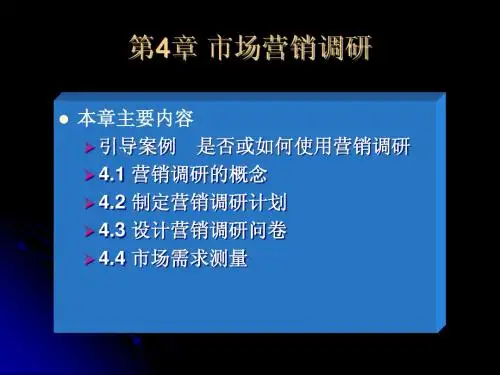
营销调研:了解市场需求,占领消费者心智【导读】营销调研是一项重要的市场工作,它通过对目标市场进行深入的研究和分析,帮助企业了解消费者需求、竞争对手动态,制定全面有效的营销战略。
在这篇文章中,我们将聚焦于阿尔文·伯恩斯所提出的营销调研方法,并探讨其在今天的营销实践中的价值和应用。
一、阿尔文·伯恩斯和他的营销调研思想阿尔文·伯恩斯是20世纪50年代在营销领域做出重大贡献的美国市场学者,他提出的营销调研思想对于营销实践产生了深远的影响。
1.定义营销调研的概念伯恩斯将营销调研定义为“收集、分析和解释与营销有关的信息来支持决策制定的过程”。
他强调了调研的目的是为了获取与营销有关的信息,并倡导在市场营销活动中实施科学、系统的调研方式。
2.营销调研的重要性在伯恩斯看来,营销调研的目标是为企业提供决策制定和市场营销活动的重要依据。
通过调研,企业可以深入了解消费者需求、产品特点、市场竞争等方面的情况,更好地创造和提供有价值的产品与服务。
二、营销调研的深度探讨1.调研设计阶段营销调研的第一步是确定调研的目标和问题。
在这一阶段,企业需要明确自己的研究目的、调查对象、调查内容等,并制定调研的计划和方法。
2.数据收集阶段在数据收集阶段,营销调研需要收集与研究目标相关的数据和信息。
常见的数据收集方法包括问卷调查、深度访谈、焦点小组讨论等。
通过这些方法,企业可以从消费者角度了解产品的优势与劣势,挖掘潜在的市场机会。
3.数据分析与解释阶段在数据收集完毕后,企业需要进行数据的分析和解释,以获取有价值的信息和见解。
在这一阶段,可以采用统计分析、质性分析等方法,对所收集到的数据进行整理、分类和归纳,最终得出结论。
4.市场营销战略制定阶段营销调研的最终目的是为企业的市场营销战略提供有效的决策依据。
通过深入了解消费者需求,企业可以根据调研结果制定全面且有效的市场推广策略,提高自身在市场中的竞争力。
三、营销调研的广度拓展1.消费者行为研究消费者行为研究是营销调研的重要领域之一。
营销策划的四步曲1--以用户需求为中心的调研-管理资料一、挖掘需求六层次需求是指在市场上能够引起客户的购买欲望,。
企业既要满足已经在市场上出现的现实性顾客需求,让每一个愿意购买企业的商品的顾客确实买到商品,也要争取那些有潜在需求的顾客,提供他们所需要的商品和服务,创造某些可以让他们买得起、可放心的条件,解除他们的后顾之忧,让他们建立起购买合算、消费合理的信念,从而将其潜在需求转变成为现实需求,前来购买企业的商品。
这就是“创造市场需求”。
而我们真正要做到的是创造需求。
一个人或者一个企业在进行每一次销售过程中,包括所有人类的思想及行动,无论在意识或潜意识上,都受到二个因素的控制,那就是追求快乐的欲望、逃避痛苦的动力。
我们归纳为:追求快乐,逃离痛苦。
一个人要产生购买冲动只有二个关键:追求快乐与逃离痛苦;痛苦的影响力要比快乐的影响力至少要大3万倍以上。
头脑在对这些快乐或痛苦的程度做比较判断时,通常会比较倾向于逃避痛苦,就是说,若有痛苦产生,则认为逃避痛苦者优先。
这也是销售切入的关键点。
案例:赵本山卖拐中央电视台春节联欢晚会上,我们看看赵本山是如何忽悠范伟的。
核心的一共四句话,我们把它罗列一下:第一句话:“最近的一段时间有没有发现身体的某些部位有变化吗?”范伟怎么说来着:“没什么变化,就感觉脸越来越大一点点?”这句话其实很正常,就像很多算命问你先生有没有感觉最近做事情有一点点不顺呢?有没有谁做事情100%顺的。
所以赵本山也是一样,脸大,然后赵本山开始忽悠范伟的第二句话:“脸大不是最主要的问题,主要的问题是你的末梢神经坏死导致你脸大”,其实这句话你听听看,从医学的角度,四个字,叫“ 不通”。
然后赵本山开始用跺脚的方法,问他脚麻吗?麻了。
所以说你腿有问题,不停地开始让他跺脚来证明他的腿有问题。
接下来开始问了第三个问题:“腿呀,不治疗它,越压越重,越压越重,轻着腿短,重着骨头坏死,晚期植物人”,所以就是这样,一说搞的范伟突然很紧张,忙问:“大哥该用点什么药呢?”赵本山又说了:“用药不好使,关键只有柱拐。
浙江商业职业技术学院2008级连锁经营管理专业《营销调研》课程教学大纲一、课程的性质、目的与任务《营销调研》是高职连锁经营管理专业必修的一门专业基础课程。
本课程是一门以经济学、市场营销学和商品学等理论为基础,研究企业市场经营活动及其规律性的应用性学科,是企业进行经营决策、改善经营管理的基础,是一切市场营销活动的起点。
连锁经营是社会化大生产的产物,是国际商业零售领域最普遍的一种经营方式和组织形式。
连锁经营的本质特征是:规模化、标准化、专业化。
要充分实现规模效益,各门店必须统一经营,采用标准化、专业化管理。
该课程的开设,符合连锁超市及相关业态企业经营管理的实际需要。
通过本课程的理论与实践教学,使学生较为系统地理解市场营销调研的基础理论,明确营销调研在连锁经营企业的商圈分析与店址选定,门店运作,卖场布局与商品陈列等经营活动中的作用,掌握消费者购买行为、产品、广告、市场需求等市场信息的处理技术,培养和提高学生对市场信息的获取能力和分析预测能力。
在教学中应注意把握理论教学与实践教学的内在联系,理论教学应借助丰富的调研实例来说明问题,实践教学应按照职业技术岗位的应知应会要求,重点掌握收集、分析市场信息的方法,可采取模拟及实地调查等方式进行。
二、课程的培养目标]知识目标[通过学习,要求学生理解营销调研的基础理论,明确营销调研在连锁经营企业的商圈分析与店址选定,门店运作,卖场布局与商品陈列等经营活动中的作用,掌握消费者购买行为、产品、广告、市场需求等市场信息的处理技术并能灵活运用。
[能力目标]通过学习,要求学生具备较强的市场信息获取能力和分析预测能力。
[素质目标]通过学习,使学生具备良好的调研道德和团队适应、协调合作的精神,成为创新型、技术型和操作型的应用人才。
三、课程内容与要求理论教学部分第一章市场调研概述(一)教学内容第一节概述一、市场与市场调查二、市场调查学科的兴起与发展三、我国市场调查业的兴起、发展与现状四、市场营销与市场调查第二节市场调研的机构与人员一、市场调研机构二、市场调研人员第三节市场调研的基本内容与方法一、企业不可控因素二、企业可控因素三、案头调查方法四、实地调查方法第四节市场调研的原则与程序一、市场调研的原则二、市场调研的程序市场调查报告的撰写第五节.一、书面调查报告二、口头调查报告(二)教学要求通过教学,使学生能够理解市场调研的相关概念,明确市场调研的机构建制与人员配备相对于连锁企业经营管理的重要性。
Determine Research DesignPart 2 deals with the general nature of designing research so that it addresses the appropriate questions efficiently. Chapter 4 provides an overview of the role of various research designs and also discusses two of the basic designs—the exploratory and the descriptive—at some length. Chapter 5 discusses the role of experiments in marketing research.Research designThe preceding chapters presented some of the kinds of problems that marketing research can help to solve. As you may have noticed, there can be great variation in the nature of the questions research might investigate. Some can be very specific: If we change the advertising mix, what might happen to sales? Others are much more general: Why have sales fallen below target? How do customers feel about the product? As you may have guessed, different formulations of a problem can lead to different research approaches to answer it.This chapter introduces the notion of research design and discusses the basic types and their interrelations. It also reviews two of the design types—the exploratory and the descriptive—in some detail. The next chapter deals with the nature of causal or experimental designs.Plan of ActionA research design is simply the framework or plan for a study, used as a guide in collecting and analyzing data. It is the blueprint that is followed in completing a study. It resembles the architect’s blueprint for a house. Even though it is possible to build a house without a detailed blueprint, doing so will more than likely produce a final product that is different from what was originally envisioned by the buyer. Like an architect’s blueprint for a house, it is the plan that is followed in completing a study. Even though it is possible to build a house without a detailed blueprint, doing so will more than likely produce a final product that is different from what the buyer envisioned. A certain room is too small; the traffic pattern is poor; some features really wanted are omitted; other less important details are included; and so on.It is also possible to conduct research without a detailed blueprint. The research findings, too, will probably differ widely from what the consumer or user of the research wanted. “These results are interesting, but they do not solve the basic problem,” is a common lament(双解词典P831). Further, just as the house built without a blueprint is likely to cost more because of midstream alterations in construction, research conducted without a research design is likely to cost more than research properly executed using a research design.Thus, a research design ensures that the study (1) will be relevant to the problem and (2) will use economical procedures. It would help the student learning research methods if there were a single procedure to follow in developing the framework or if there were a single framework to be learned. Unfortunately, this is not the case.Rather, there are many research design frameworks, just as there are many unique house designs. Fortunately, though, just as house designs can be broken into basic types (for example, ranch, split-level, two-story), research designs can be classified into some basic types as well. One very useful classification is in terms of the fundamental objective of the research: exploratory, descriptive, or causal.Types of Research DesignThe major emphasis in exploratory research is on the discovery of ideas and insights. The soft-drink manufacturer faced with decreased sales might conduct an exploratory study to generate possible explanations.The descriptive research study is typically concerned with determining the frequency with which something occurs or the relationship between two variables. The descriptive study is typically guided by an initial hypothesis. An investigation of the trends in the consumption of soft drinks with respect to such characteristics as age, sex, and geographic location would be adescriptive study.A causal research design is concerned with determining cause-and-effect relationships. Causal studies typically take the form of experiments, because experiments are best suited to determine cause and effect. For instance, a soft-drink manufacturer may be interested in ascertaining the effectiveness of different advertising appeals. One way for the company to proceed would be to use different ads in different geographic areas and investigate which ad generated the highest sales. In effect, the company would perform an experiment, and if it was designed properly, the company would be in a position to conclude that one specific appeal caused the higher rate of sales.Having stated the basic general purpose of each major type of research design, three important caveats are in order. First, although the suggested classification of design types is useful for gaining insight into the research process, the distinctions are not absolute. Any given study may serve several purposes. Nevertheless, certain types of research designs are better suited to some purposes than others. The crucial tenet of research is that the design of the investigation should stem from the problem. Each of these types is appropriate to specific kinds of problems.Second, in the remainder of this chapter and in the next chapter, we shall discuss in more detail each of the design types. The emphasis will be on their basic characteristics and generally fruitful approaches. Whether or not the designs are useful in a given problem setting depends on how imaginatively they are applied. Architects can be taught basic design principles; whether they then design attractive, well-built houses depends on how they apply these principles. So it is with research. The general characteristics of each design can be taught. Whether they are productive in a given situation depends on how skillfully they are applied. There is no single best way to proceed, just as there is no single best floor plan for, say, a ranch-type house. It all depends on the specific problem to be solved. Research analysts, then, need an understanding of the basic designs so that they can modify them to suit specific purposes.Third, the three basic designs can be looked at as stages in a continuous process. Figure 4.1 shows the interrelations. Exploratory or formulative studies are often seen as the initial step. When researchers begin an investigation, it stands to reason that they lack a great deal of knowledge about the problem. Consider, for example, the following problem: “Brand X’s share of the disposable diaper market is slipping. Why?” This statement is too broad to serve as a guide for research. To narrow and refine it would logically be accomplished with exploratory research, in which the emphasis would be on finding possible explanations for the sales decrease. These tentative explanations, or hypotheses, would then serve as specific guides for descriptive or causal studies.Suppose the tentative explanation that emerged was that “Brand X is an economy-priced diaper, originally designed to compete with low-cost store-brand diapers. Families with children have more money today than when the brand was first introduced and are willing to pay more for higher quality baby products. It stands to reason that our market share would decrease.”The hypotheses that families with small children have more real income to spend and that a larger proportion of that money is going toward baby products could be examined in a descriptive study of trends in the baby products industry.Suppose that the descriptive study did support the hypotheses. The company might then wish to determine whether parents were, in fact, willing to pay more for higher quality diapers and, if sowhat features (such as better fit or greater absorbency) were most important to them. This might be accomplished partially through a test-marketing study, a causal design.Each stage in the process thus represents the investigation of a more detailed statement of the problem. Although we have suggested that the sequence would be from exploratory to descriptive to causal research, alternative sequences might occur. The “families with small children have more money to spend on baby products” hypothesis might be so generally accepted that the sequence would go from exploratory directly to causal. The potential also exists for conducting research in the reverse direction. If a hypothesis is disproved by causal research (for example, the product bombs in the test market), the analyst may then decide that another descriptive study, or even another exploratory study, is needed. Also, not every research problem will begin with an exploratory study. It depends on how specific researchers can be in formulating the problem before them. A general, vague statement leads naturally to exploratory work, whereas a specific cause-effect hypothesis lends itself to experimental work.Research Realities 4.1, for instance, lists some of the individual projects that were conducted by PepsiCo to support the conception and introduction of O’Grady’s potato chips. In this instance, the examination of the potato chip category with respect to market shares and trends, the ideation sessions, and the focus groups to help develop meaningful ways to describe a thick potato chip could all be classified as exploratory research. The diary panel that was set up to measure trial and repeat purchase behavior would be considered descriptive, and the market simulation test and the test of the commercial would be considered causal.Figure 4.1 Relationships among Research DesignsExploratory ResearchAs previously stated, the general objective in exploratory research is to gain insights and ideas. The exploratory study is particularly helpful in breaking broad, vague problem statements into smaller, more precise subproblem statements, it is hoped in the form of specific hypotheses. A hypothesis is a statement that specifies how two or more measurable variables are related. A good hypothesis carries clear implications for testing stated relationships. In the early stages of research, we usually lack sufficient understanding of the problem to formulate a specific hypothesis. Further, there are often several tentative explanations for a given marketing phenomenon. For example: Sales are off because our price is too high; our dealers or sales representatives are not doing the job they should; our advertising is weak; and so on. Exploratory research can be used to establish priorities in studying these competing explanations. The priorities would be established because a particular hypothesis discovered in the exploratory study appears to be promising. They might also arise because the exploratory study generates information about the practical possibilities of researching specific, conjectural statements.The exploratory study is also used to increase the analyst’s familiarity with the problem. This is particularly true when the analyst is new to the problem arena (for example, a marketing research consultant going to work for a company for the first time).The exploratory study may be used to clarify concepts. For instance, management is considering a change in service policy that will, it is hoped, result in improved dealer satisfaction. An exploratory study could be used to clarify the notion of dealer satisfaction and to develop a method by which dealer satisfaction could appropriately be measured.When Congress discusses revising the tax code in order to make it “more fair’(so as to increase taxpayer compliance), a problem that often surfaces is how to determine what fairness in the tax code means. Is it tax enforcement that bothers people? Tax avoidance by other people? The way tax laws are written? Tax rates? That people believe their tax dollars are being poorly spent? Exploratory research would play a particularly important role in clarifying a concept such as this.Research Realities 4.1Research Supporting the Development and Introduction of O’Grady’s Potato Chips As a first step, Frito-Lay examined whether or not a consumer need existed for a different type of potato chip. An inventory was made of the potato chip product category. There were relatively few options available. Potato chips on the market were either flat or ridged, unflavored or cheese flavor or flavored with sour cream and onion. Yet Frito-Lay knew that consumers seek variety and often differentiate between products on a textural basis.At the corporate level, a number of hurdle criteria were set: a $100-million-plus business, it had to add incremental volume, it had to have broad national appeal, and it had to be a unique, not easily replicated product.To start with, new product ideas were developed through a number of sources. Ideation sessions were conducted with scientists, the marketing department, home economists, and consumers. Recipe books were collected, and the industry’s packaged potato snack products were purchased from stores and studied for differentiation opportunities, for needs that weren’t being filled.Four distinct product ideas resulted from this exercise: a “better Pringles,”which was dropped on judgment due to Pringles’ lack of success; a “potato Frito,” a thicker, processed chip that later became “crunch chips”; a super-crispy chip that became Ta-Tos; and a bite-sized, latticed chip—a small, thin, fragile O’Grady’s forerunner. The ideas were exposed to consumers forerunner. The ideas were exposed to consumers through product evaluation groups, which provided direction on product refinement and positioning issues. The results suggested that development should continue on all three, although the crunch chips and the Ta-Tos were the most well received at this stage. The O’Grady’s product was deemphasized because consumers saw it as too light and thin.Even though the Ta-Tos and crunch chips were well received and eventually went to test market, they did not fit with the business objective of being a new potato chip. Despite its consumer rejection, the lattice chip, which was to become O’Grady’s, offered the most differentiable potato chip. O’Grady’s was then taken from thin and crispy to the other end of the spectrum—thicker, heavier, and crunchier. The lattice cut gave it a unique appearance. The thickness gave it a unique texture (crunchiness) and taste (more potato taste). Home-use tests confirmed that the shift to thickness was positive, and focus group research was conducted to help develop meaningful, motivating ways of describing a thick potato chip. Crunchy, hearty, and more potato taste seemed to be most appealing.From a market simulation test. The interest-generating ability of the concept and the fit of the product with the concept, as well as the trial and repeat and volume potential of the brand, weredetermined. Only two sizes and a plain flavor were tested. The results were positive, but they indicated that the product wouldn ’t surpass the corporate hurdle rate. So, an additional au gratin cheese flavor was developed and was selected using further home-use tests. At the same time, focus group copy development research led Frito-Lay to emphasize or embody simplicity, small-town values, implied wholesomeness, and heartiness. This commercial, opening with a potato plant, was found to be positively intrusive and memorable and to elicit positive consumer reactions with appropriate images being conveyed.While in test market, a full range of research was conducted to monitor O ’Grady ’s performance. An awareness and trial study was conducted. A diary panel was set up to measure trial, repeat, and depth of repeat. An image study was set up to make sure the desired positioning was conveyed. Finally, distribution checks helped monitor distribution and out-of-stock levels. These test market data allowed for fine-tuning of the national program and also provided standards against which to measure O ’Grady ’s performance during expansion.In sum, an exploratory study is used for any or all of the following purposes:Formulating a problem for more precise investigation or for developing hypothesesEstablishing priorities for further researchGathering information about the practical problems of carrying out research on particular conjectural statementsIncreasing the analyst ’s familiarity with the problemClarifying conceptsIn general, exploratory research is appropriate to any problem about which little is known. Exploratory research then becomes the foundation for a good study.Because knowledge is lacking when an inquiry is begun, exploratory studies are characterized by flexibility with respect to the methods used for gaining insight and developing hypotheses. Exploratory studies rarely use detailed questionnaires or involve probability sampling plans. Rather, investigators frequently change the research procedure as the vaguely defined initial problem is transformed into one with more precise meaning. Investigators follow where their noses lead them in an exploratory study. Ingenuity, judgment, and good luck inevitably play a part in leading to the one or two key hypotheses that, it is hoped, will account for the phenomenon.Notwithstanding the flexibility, research experience has demonstrated that literature surveys, experience surveys, focus groups, and the analysis of selected cases are particularly productive in exploratory research. See Figure 4.2.Figure 4.2 Types of Exploratory StudiesLiterature SearchOne of the quickest and cheapest ways to discover hypotheses is in the work of others, Exploratory Studies Literature SearchExperience SurveyFocus GroupsAnalysis of Selectedthrough a literature search. The search may involve conceptual literature, trade literature, or, quite often, published statistics.The literature that is searched depends, naturally, on the problem being addressed. Miller Business Systems Inc. of Dallas, for example, routinely monitors trade literature to keep track of its competitors. The information on each competitor is entered into the “competitor profiles” that it keeps in its database. The company regularly scans these profiles for insights on what the competition might be doing. One such scan indicated that one competitor had hired nine furniture salesmen in a 10-day period. This was a tip-off to a probable push by the competitor in the office furniture market. With this early notice. Miller was able to schedule its salespeople to make extra calls on their accounts, thereby blunting the competitor’s sales drive.Sometimes conceptual literature is more valuable than trade literature. For example, a search of conceptual literature would be warranted for a firm whose management believes that its field sales force is largely dissatisfied. The search would include works on psychology, sociology, and personnel, in addition to marketing journals. The focus would be on the factors determining employee satisfaction-dissatisfaction. The analyst would keep a keen eye out for those factors also found in the company’s environment. The question of how to measure an employee’s satisfaction would also be researched at the same time.Suppose the problem is one that typically triggers much marketing research: ‘Sales are off. Why?” Exploratory insights into this problem could easily and cheaply be gained by analyzing published data and trade literature. Such an analysis would quickly indicate whether the problem was an industry problem or a firm problem. Very different research is in order if the firm’s sales are down but (1) the company’s market share is up, because industry sales are down farther; (2) the company’s market share has remained stable; or (3) the company’s market share has declined. The last situation would trigger an investigation of the firm’s marketing-mix variables, whereas the first condition would suggest an analysis to determine why industry sales are off. The great danger in omitting exploratory research is obvious from the preceding example; without the analysis of secondary data as a guide, there is a great danger o researching the wrong “why.”A company’s own internal data should be included in the literature examined in exploratory research, as Mosinee Paper Company found to its pleasant surprise. The company was contemplating dropping one of its products because of its dismal sales performance. Before doing so, though, the company tallied sales of the product by salesperson and found that only a single salesperson was selling that specific grade of industrial paper. On further investigation. Mosinee discovered how the buyers were using the paper—an application that had been known only to the one salesman and his customers. This information enabled management to educate its other salesmen as to the potential market for the paper and sales rose substantially.It is important to remember that in a literature search, as in any exploratory research, the major emphasis is on the discovery of ideas and tentative explanations of the phenomenon and not on demonstrating which explanation is the explanation. The demonstration is better left to descriptive and causal research. Thus, the analyst must be alert to the hypotheses that can be derived from available material, both published material and the company’s internal records.Experience SurveyThe experience survey, sometimes called the key informant survey, attempts to tap the knowledge and experience of those familiar with the general subject being investigated. For example, a San Francisco builder focused on architects and designers when trying to get a handleon its competitors. The company asked these people to describe the traits of builders that tended to turn off buyers of expensive homes. Some of the answers included bad manners, workers who tracked dirt across carpets, and beat-up construction trucks, which buyers objected to having parked in their driveways. The company used these insights for a major repositioning of its business to the Bay Area’s upper crust. The company bought a new truck, had its estimators don jackets and ties, and made sure its work crews were impeccably polite. For example, the crews began rolling protective runners over carpets before they set foot in clients’ homes. In less than two years, the company’s annual revenue more than quintupled.In studies concerned with the marketing of a product, anyone who has any association with the marketing effort is a potential source of information. This would include the top executives of the company, sales manager, product manager, and sales representatives. It would also include wholesalers and retailers who handle the product as well as consumers who use the product. It might even include individuals who are not part of the chain of distribution but who might, nevertheless, possess some insight into the phenomenon. For example, a publisher of children’s books investigating a sales decrease gained valuable insights by talking with librarians and schoolteachers. These discussions indicated that an increased use of library facilities, both public and school, coincided with the product’s sales decline. These increases were, in turn, attributed to a very sizable increase in library holdings of children’s books resulting from federal legislation that provided money for this purpose. Similarly, when designing the Louisville, a medium-duty conventional truck intended for beverage distribution, among other things, Ford Motor sought market information from fleet owners, mechanics, and drivers.Usually, a great many people know something about the general subject of any given problem. However, not all of them should be contacted.Research economy dictates that the respondents in an experience survey be carefully selected. The aim of the experience survey is to obtain insight into the relationships between variables rather than to get an accurate picture of current practices or a simple consensus as to best practices. One is looking for provocative ideas and useful insights, not for the statistics of the profession. Thus the respondents must be chosen because of the likelihood that they will offer the contributions sought. In other words, a selected sample of people working in the area is called for.One does not, therefore, use a probability sample in an experience survey. It is a waste of time to interview those who have little competence or little relevant experience. It is also a waste of time to interview those who cannot articulate their experience and knowledge. It is important, though, to include people with differing points of view. The following were all interviewed with varying degrees of success when the children’s books sales decline was being researched: company executives, key people in the product group, sales representatives, managers of retail outlets in which the books were sold, teachers, and librarians.The interviews were all unstructured and informal. The emphasis in each interview among those immediately concerned with the distribution of the product was “How do you explain the sales decrease? In your opinion, what is needed to reverse the downward slide?” Most of the time in each interview was then devoted to exploring in detail the various rationales and proposed solutions. A number of sometimes conflicting hypotheses emerged. This provided the researchers with an opportunity to “bounce” some of the hypotheses off groups with differing vantage points and, in the process, get a feel for which of the hypotheses would be most fruitful to research. The interviews with librarians and teachers were divorced from the immediate problem. Here theemphasis was on discovering changes in children’s reading habits.The respondents were given a great deal of freedom is choosing the factors to be discussed. This is consistent with the notion that the emphasis in exploratory research is on developing tentative explanations and not on demonstrating the viability of a given explanation.Focus GroupsFocus groups are another useful method for gathering ideas and insights. In a focus group, a small number of individuals are brought together in a room to sit and talk about some topic of interest to the focus group sponsor. The discussion is directed by a moderator. The moderator attempts to follow a rough outline of the issues under consideration, while at the same time making sure that the comments made by each person present are included in the group’s discussion. Each individual is thereby exposed to the ideas of the others and submits his or her ideas to the group for consideration.Focus groups are one of the more frequently used techniques in marketing research; they have proved to be productive for a variety of purposes, including the following:1.To generate hypotheses that can be further tested quantitatively2.To generate information helpful in structuring consumer questionnaires3.To provide overall background information on a product category4.To secure impressions on new product conceptsFor example, in designing its Z3 roadster, BMW conducted focus groups in Japan, the United States, the United Kingdom, and Germany. The American influence is visible in the dual cupholders, the coinholder, and the third brake light.Research Realities 4.2 discusses the insights Harley-Davidson gleaned from focus groups.Although focus groups do vary in size, most consist of eight to twelve members. Smaller groups are too easily dominated by one or two members; with larger groups, frustration and boredom can set in, as individuals have to wait their turn to respond or get involved. Respondents are generally selected so that the groups are relatively homogeneous, minimizing both conflicts among group members on issues not relevant to the study objectives and differences in perceptions, experiences, and verbal skills. Differences that are too great with respect to any of these characteristics can intimidate some of the group participants and stifle discussion.Research Realities 4.2Experience of Harley-Davidson with Focus Groups After making a remarkable comeback in the 1980s, motorcycle manufacturer Harley-Davidson had buyers on two-year-long waiting lists all over the country. But that success placed the company in a familiar quandary: Should Harley expand and risk a market downturn, or should it stay the course, content with its good position in the industry?“To invest or not to invest, that was the question,” said Frank Cimermancic, Harley’s director of business planning. “Dealers were begging us to build more motorcycles,”he said. “But you have to understand our history. One of the things that caused past problems was a lack of quality, and that was the result of a too-rapid expansion. We did not want to relive that situation.”The company’s dilemma was complicated by the fact that the market for heavyweight bikes was shrinking. “We were doing fine, but look at the market,”Cimermancic said. “Maybe, we thought, we could reverse these trends and become an industry leader, something we hadn’t been for a long time.”A new kind of customer seemed to hold the keys to market growth. White-collar motorcycle。